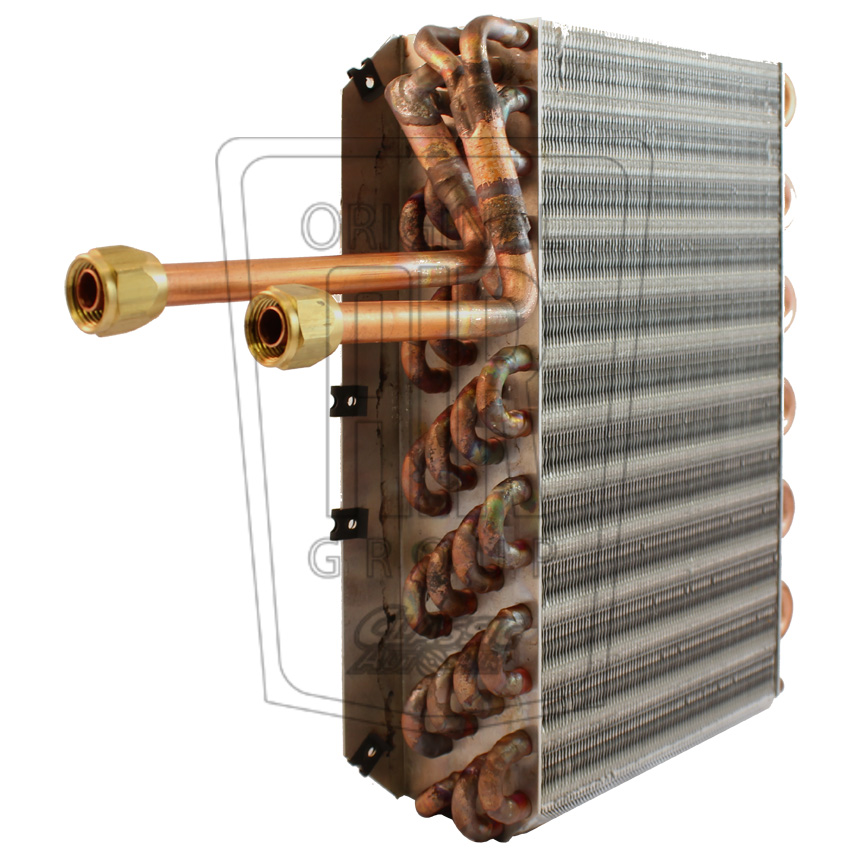- Register
- Log in
- Wishlist (0)
- Cart (0) You have no items in your shopping cart.
Restoration - Ford Evaporators
Evaporators
What does an evaporator do?
The evaporator is the coil that is located in a box (called an evaporator housing or plenum) mounted behind the dash or on the firewall in the engine compartment. It receives liquid refrigerant that is metered into it from the expansion valve. As the refrigerant enters the evaporator, it boils into gas form, causing the coils & fins to frost up. The air that is forced through the frigid evaporator coil is ultimately pushed through various ducts and louvers before entering the passenger compartment. The evaporator, along with the Condenser, is the most important part in the a/c system at determining how cold vent temperature is.
Why restore or replace your evaporator?
Over time, many things can decrease the efficiency of your car’s evaporator. Dirt & debris can block cooling fins and restrict or block air flow, causing marginal or even hot vent temperature or it can simply develop a leak. In some cases, a more efficient replacement evaporator is available. When converting to 134a, it is highly recommended to replace your original evaporator with a more efficient coil if available. More on Converting to 134a!
Classic Auto Air offers new & reconditioned replacement evaporators for 64½-73 Ford Mustang, 67-73 Mercury Cougar & 58-66 Ford Thunderbird, and restoration & duplicating services for situations when a new or reconditioned replacement is not available.
Buy a New Evaporator Coil
Classic Auto Air also offers new high performance replacement evaporators for all 64½-73 Ford Mustang & 67-73 Mercury Cougar. These coils are improved by adding 35% more passes. (see photos) IDEAL FOR CONVERTING TO 134a! More on Converting to 134a!
New 1967 - 68 Mustang Evaporator Coil
Part # 1-104
New 1969½ - 70 Mustang Evaporator Coil
Part # 1-106
1971-73 Mustang Evaporator Coil - New
Part #1-107
Our new high-performance evaporators give you approximately 35% more passes, which improve system efficiency. Ideal for converting to 134a! Available for all 1964½-73 Mustangs & 1967-73 Cougars.
Call or Message Us!
Evaporator Reconditioning
Classic Auto Air can also recondition your original evaporator.
Typical Evaporator - Before & After


Evaporator reconditioning consists of:
- Bead blast & clear coat end-tubes, fittings & mounting brackets
- Pressure test & flush clean internally
- Acid wash externally
- Straighten fins
Evaporator - Mustang Under Dash Unit Restoration
Classic Auto Air restores 1964½ - 66 Mustang under dash units.
- Disassemble, inspect, clean and replace damaged or missing parts
- Clean and repair fiberglass housing
- Recondition or replace evaporator, expansion valve, blower motor, fan & thermostat, etc.
- Glass bead & repaint all parts
- Polish knobs and repaint emblem
- Re-chrome plate face bezel ($250 value - most Fords)
- New air registers ($19.95 value)
- New coin tray on 64½ - 65 units ($35.90 value)
- New
Caution
decal on blower housing ($4.50 value)
Call or Message Us!
Evaporator & Heater - In Dash Plenum
Restoration
This is a restoration of the whole unit that houses the evaporator & heater coil for models where the evaporator unit is IN (rather than under) the dash, including restoring the evaporator itself.
Typical 1967-73 Mustang & Cougar - Before & After


The restoration of a 1967-73 Mustang under dash unit includes:
- Disassemble, inspect, clean and replace damaged or missing parts
- Clean & repair fiberglass housing
- Recondition or replace evaporator
- Replace, recondition or re-core heater coil
- Replace all foam seals
Call or Message Us!





